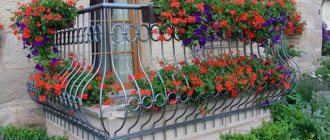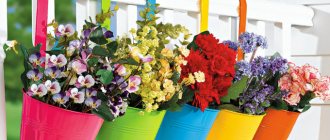Flowers love the sun and warmth, so it seems that in other conditions they survive with difficulty. But there are many plants that will grow well and even bloom in shade or partial shade. Choose beautiful pets for your balcony!
Northern balconies greatly upset flower growers: plants here develop poorly, stretch out in search of the sun, and bloom poorly. In urban environments, balconies and loggias with a northern orientation, even in summer, receive a minimum of sunlight. The lighting is mostly diffuse. This means that moisture evaporates more slowly here. One of the common problems of such premises is dampness and mold. If the balcony is open, the temperature here will always be much lower than in sunny areas of the street.
It is often windy on high floors, and the adjacent walls of houses are additional sources of shadow. Drafts also cause a lot of problems. On closed balconies the conditions are a little better, at least there is no wind and it is warmer at night. But because of the glass, the light becomes even less. Not all flowers can grow well in such conditions. We present popular representatives of the flora that you should plant on your northern balcony.
The best shade-tolerant plants for a northern balcony
Shade-tolerant plants are ready to put up with the lack of sun, although they would do well on the brighter side. With proper care, they will love it on your balcony or loggia, and you will even be able to enjoy their unusual flowering.
When purchasing plants for a northern balcony, always choose strong and healthy specimens. This is important because flowers in ordinary supermarkets do not receive sufficient care and, if exposed to harsh conditions, even shade-tolerant plants can die. Contact only specialized stores where plants are properly cared for.
Features of planting crops for vertical plantings
Climbing plants require special care. To grow plants, special soil is required. Ready-made flower soils are popular. They contain a set of microelements and humic substances to stimulate growth.
When using ordinary soil, it is worth using organic fertilizer. Plants grown in containers require more careful care and require daily watering. In hot weather, watering is done two or three times a day.
Climbing plants need to be fed regularly. Organic fertilizers such as Rainbow or Ideal are used, which allow the development of a strong root system and resistance to environmental factors. During the growing season, regular pruning of faded inflorescences is necessary.
Clematis is very beautiful and easy to grow.
Plants can be placed in planters or pots that are hung from a window or even from the ceiling. Containers are placed on hanging shelves or racks. Clematis is planted in special baskets. Annual vines not only add greenery to the balcony, but also hide all sorts of effects.
Astilbe
Astilbe is a luxurious herbaceous perennial with delicate inflorescences and graceful leaves. Low-growing varieties of various shades are suitable for the balcony. Plants will look great in large pots that can be placed on the floor or stand. In different species, flowering occurs in June, July or August.
How to care for astilbe on the balcony
Most of all, astilbe does not like dryness, so it needs to be watered regularly, making sure that the soil is always moist. For successful flowering, plant the plant in fertile soil. The rhizome of the plant is close to the surface. To prevent it from drying out, mulch the soil in the pot.
From spring to autumn, astilbe needs feeding with potassium and phosphorus (twice a month). You can use store-bought complex fertilizers according to the instructions. After flowering, carefully cut off the inflorescences.
- The best varieties of astilbe: photos, names, descriptions
A selection of the most beautiful varieties of astilbe with photos and detailed descriptions.
Balsam
If you are looking for a beautiful and unpretentious plant, pay attention to garden balsam. It is also called impatiens because, during ripening, the flower's seed pods release their contents if touched. The variety of shades of balsam will amaze even experienced gardeners. And most importantly, the plant feels great on the northern balcony! In the shade, balsam leaves acquire a brighter color, which is not so common in the plant world.
On the northern balcony, balsams of bright colors may fade, so it is better to choose white or light pink varieties. They will look especially impressive in a composition with deciduous perennials (hosta, ivy, etc.).
How to care for balsam
Impatiens love moist soil, but drought is dangerous for it: not only the roots, but the entire flower can suffer. The fact is that the plant is not resistant to spider mites, which settle in dry areas. Therefore, for prevention, regularly spray the bushes with water. You can achieve ideal flowering under a simple condition: if you propagate plants from cuttings. They also grow well from seeds, but do not bloom as luxuriantly. As for the soil, give preference to fertile and light substrate.
Do not place the pot with balsam in a draft, otherwise the plant will get sick.
Ampelous flowers for the balcony
A well-kept balcony always attracts the glances of passers-by, especially if it is beautifully decorated with flowers. Lush vegetation can not only transform the facade of a house, but also create a living wall that will protect from the scorching sun in the hot summer.
Climbing specimens occupy a leading position in the design of a balcony. We will talk further about which flowers are preferable to grow outside the window of a city apartment.
Begonia
An excellent option for a northern balcony is an unpretentious ever-blooming begonia. It tolerates shading well and also needs high air humidity, so it should like it on your balcony. Blooms all summer. Of course, it is not always possible to wait for lush flowering, but with proper care the plant will delight you with its charming flowers.
How to care for begonia on the balcony
Begonia is demanding on the composition of the soil and loves fertile, acidified soil most of all. Watering is needed regularly and abundantly, but do not allow moisture to stagnate. Use settled and soft water. The plant will be grateful if on dry and hot days you place the pot in a container with wet pebbles for cooling. You can feed begonia with the usual complex flower food (2 times a month).
Begonias are often affected by aphids, thrips and powdery mildew, so regularly inspect the plants and do preventive spraying with a soap solution.
- Begonia from seeds and tubers: is it easy to grow?
If you cannot find begonia tubers of a certain variety on sale, you can get plants from seeds.
Placement of a flower garden
Now let's think about the design of the pots and how to fit your greenhouse into a fairly small balcony area. If you try and think through everything, the flower garden will become your pride!
So, let's prepare a place for flowers. This can be done on a budget by decorating in the simplest way using aerosol cans of paint and stencils all the old flower vases and pots you have at home in the same color, or by allocating a certain amount to buy new, modern ones. Do not forget that for climbing plants, in addition to pots, you need to string ropes or make supports. By the way, it is climbing plants that will give your apartment coolness on a hot day.
Viola
Bright violas, or pansies, are found in almost every garden. But you can successfully grow this flower on the balcony. Viola is completely unpretentious and will delight you with flowering until autumn. Usually it is planted on sunny balconies, but there pansies can suffer from the heat. Therefore, the northern one is a very good alternative.
And if the sun hits your balcony even occasionally, pansies will bloom much longer than if they grew in bright light.
Be prepared for the fact that when planted in the shade, the viola will bloom smaller and slightly paler than when grown in the sun.
How to care for viola
Viola loves light and loose soil. You need to water the soil as soon as it dries out a little. Moderate watering will help avoid rot, which affects the tender roots of the viola. To achieve flowering, feed the flower weekly with complex fertilizers and inspect it for pests. And once every 10 days, loosen the soil so that a dry crust does not form on the surface. When planting seedlings, leave at least 15-20 cm between plants so that the roots feel comfortable.
Annuals that can tolerate shade
Not all of these flowers retain their vibrant color without prolonged absence of sunlight. But they bloom non-stop throughout the summer season.
Cosmea
The cheerful color of the unpretentious shade-tolerant cosmos flower delights with colors until late autumn. The plant is drought-resistant, up to 1.5 m high with 10-12 cm flowers. It blooms more profusely if you pick off the dried baskets.
Nasturtium
Unpretentious, drought-resistant nasturtium grown in the shade has fewer flowers, but the leaves grow bright and large, which are used for salads.
The bushes are low, up to half a meter in height. Grow by seeds in the ground or through seedlings in separate pots.
Marigold
Common flowers for both shady and sunny balconies. The choice is wide - from low-growing varieties, with a height of 15 cm, to tall bushy specimens.
Double and simple flowers have been bred. Tagettes love warmth and water, bloom all summer, and are easy to grow. Picking off dried flowers helps prolong flowering.
Petunia
The favorite petunia is grown both in boxes and in hanging flowerpots. Small flowers and large ones, simple and double, compact plants and ampelous ones - there are so many varieties that have not yet been bred. The balcony is decorated with cold-resistant hybrids.
Calendula
Calendula and marigolds are undemanding to the soil; for long-term flowering, you need to pick off the dried flowers. Sow seedlings in February, preferably low-growing varieties. It goes well with viola, petunia and herbs.
Snapdragon
The low-growing snapdragon pleases not only with the colorful flower baskets, but also with its fragrance. With the onset of frost, the corollas freeze, retaining their color, and decorate the balcony in winter.
Nemesia
One-, two- and three-color nemesia flowers bloom when it is not very hot, in late summer. Therefore, it is better to sow flowers for seedlings in June.
Low bushes with small bright flowers create a delicate design and give a good mood.
Conclusion
With shade-tolerant annuals, it is not difficult to decorate a balcony on any side of the house. Easy care, ease of sowing and growing will help you create your own blooming mini-garden.
Dicentra
An exquisite dicentra will decorate the northern balcony. Its heart-shaped flowers will not leave anyone indifferent! In addition, dicentra gets along well with other crops; you can plant it in the same flowerpot, for example, with hostas or primroses. In the sun the plant blooms faster (usually in the second half of May), but in the shade the flowering period lasts much longer. Sometimes the plant will bloom again in August, which will be a pleasant surprise.
How to care for dicentra on the balcony
Drained, oxygenated and well-moistened soil without stagnant water is what dicentra needs for proper growth. Regularly loosen the soil under the bush and feed the plant with nitrogen fertilizers during the flowering period. The flower does not like frequent transplants. After flowering, all branches need to be trimmed, leaving stems up to 5 cm long. This way you will ensure the plant has a quiet winter.
If you like this flower, you can plant it in the garden.
- Growing dicentra in the garden
Everyone knows this amazing plant with clusters of hearts hanging from the branches. But how to grow it?
Calceolaria
Experienced flower growers should start a calceolaria. The name of the plant is translated from Latin as “slipper” due to the shape of the flower. True, to some people they resemble bags or wallets. The diameter of one flower reaches 6 cm, and up to 50 of these “slippers” can bloom on a plant – an incredibly beautiful sight! Calceolaria prefers diffused light and does not like excess heat. Therefore, it will feel good on the northern balcony.
How to care for calceolaria on the balcony
This plant is quite capricious and requires constant care. The ideal temperature for it is 14-16°C; in a hot room it can shed leaves and even buds, so keep this in mind if you have a glazed balcony. Water the plant when the soil dries out a little. In hot weather, place the calceolaria pot on a tray of damp pebbles to increase the humidity. It is usually grown as an annual crop: after flowering, which occurs in spring or June, the plant is dug up.
When watering, do not irrigate the stems and leaves. Only flowers can be sprayed.
What and how to choose for a shady balcony
There is little sun on the north and east sides of the house, but sometimes on the south and west sides the balcony is in the shade from trees or neighboring houses.
What kind of plants should be for shady balconies:
- drought-resistant;
- compact;
- long-blooming;
- shade-tolerant;
- shade-loving;
- frost-resistant;
- preferably annual species.
It is worth watering, focusing on the weather and temperature conditions.
Shade-tolerant annuals are happy with 3-5 hours of sunlight, but for some species this negatively affects the number of flowers and the duration of color. Light partial shade is more suitable.
Among annual crops, give preference to shade-tolerant flowers:
- asters and chamomile;
- ageratum and mirabilis;
- nasturtium and calendula;
- Iberis;
- marigolds and nasturtiums;
- scabise, rudbeckia, resin and other flowers.
Sowing seeds for seedlings March - April.
Shade-loving annuals prefer diffused light for 3-4 hours a day. These plants have dark and lush, richly colored foliage. Shade-loving flowers include:
- balsam and begonia;
- mimulus and calceolaria;
- sweet tobacco and climbing peas;
- saxifrage, alyssum, lobelia.
The seeds of these annuals are sown in February.
Primrose
Primrose, or primrose, is a perennial plant with bright, delicate flowers. At the dacha, it is usually planted in the shade under trees or near stones. But even on the northern balcony this flower will develop well if you give it a little attention. Primrose blooms in the spring, but some tall species, such as Byss primrose and Japanese primrose, bloom from June to August.
How to care for primrose on the balcony
Garden primrose easily adapts to life in the shade. It loves loose, slightly acidic soil, so regularly loosen the soil in the flowerpot. Regular watering is required. The soil under the bushes can be mulched with gravel. During the season, feed the plant with complex fertilizers. Remove faded inflorescences and faded leaves - and the primrose will delight you with its flowering for a long time!
Two principles of landscaping balconies
Horizontal gardening
As the name implies, this method can primarily apply to floors and railings. It involves the following types of design:
- By attaching a long flower container (or several pieces close to each other) to the railing on the outside or inside of the balcony, you get a continuous horizontal line of flowers.
- If the same structure is placed on the floor, only the level of viewing will change.
- The structure can be divided into parts and placed horizontally in two tiers, one above the other, or on shelves in a “cascade” or “ladder”.
This technique in medium-sized areas creates a feeling of coziness, comfort and rational order, the effect of neatness and style.
Vertical gardening
Vertical gardening can be considered the decoration of vertical surfaces with plants - windows and doors, external and internal walls. Often, hanging or climbing flowers for the balcony are planted in boxes, containers or tubs.
- A box or pot is placed against the wall on the floor, and supports are attached to it, along which the shoots of the plant will then crawl upward.
- Containers can be mounted on hinges, then the structure will become mobile.
- Another option would be to install racks along the walls on which flower pots will be placed.
- Naturally, you can use a variety of wall-mounted pots, plant pots and hanging baskets that are attached to the ceiling.
From a design point of view, verticality plays a fairly important role. A solemn and majestic pattern, formed from verticals repeated at the same pitch, creates a feeling of security, both physical and psychological.
One of the best solutions to obtain a continuous green mass is to plant annual vines that grow quickly. To give them the required shape, they are spread over different supports, trellises and gratings. Liana shoots can also provide a service from a purely utilitarian side, perfectly masking all sorts of architectural defects.
Vertical gardening looks very beautiful on glazed balconies. Here plants are not threatened by bad weather or gusts of wind, and a small space can become a blooming oasis all year round. In this case, plants such as fuchsia, petunia, tuberous begonia, winged thunbergia, ampelous varieties of lobelia and pelargonium are suitable.
The choice of colors is very large. Which one to choose should first be determined by your taste, and your decision should be confirmed by the location of the balcony.
Flowers on the sunny side
For a balcony located on the sunny side, flowering plants are more suitable. They look much more attractive and can bestow their colors for a long time. On the sunny side, many of the balcony plants bloom well and for a long time, perhaps with the exception of begonia and fuchsia. Excessive sun is contraindicated for them, it suppresses them and the flowers begin to wither, and sometimes they don’t bloom at all.
Particularly “greedy” for sun and warmth are purslane, morning glory, kobea, dimorphotheca and dorotheanthus. For example, grandiflora purslane simply does not open its flowers on cloudy days, and in cool summers it blooms sparingly even on the south side.
Asters, daisies, mignonette, godetia, dahlias, gatsania, ageratum, heliotrope, balsam, lobelia, violas, sweet peas, ampelous pelargonium, morning glory, nasturtium, petunia - an excellent set of flowers.
You can plant Indian canna and African agapanthus in large pots or tubs. You can get an amazing mini-flower garden by placing Drummond phlox, graceful zinnia and grandiflora tobacco in one container.
If you start planting evergreen begonia, daisies and violas at the very beginning of May and continue to plant asters, kobeya, gatsania, petunia, lantana, sedum and tuberous begonia, the balcony will continue to bloom until the end of October.
Flowers for the north side
On the western and, to a greater extent, on the northern side, there is a strong lack of light, from which many plants suffer, which somewhat limits their choice. Feeling quite good:
- among the flowering ones - marigolds (tagetes), fuchsia, periwinkle, tuberous begonia, forget-me-nots, mignonette, astilbe, fragrant tobacco;
- from pots - cherry laurel, oleander, balsam, tradescantia, aspidistra, cissus, zebrina, conifers;
- climbing ones include ivy and ampelopsis.
When choosing flowers for a northern balcony, it is better to give preference to decorative foliage plants, which attract attention with their leaves in bizarre shapes.
On the north side, most of the plants really bloom poorly, however, if you grow potted seedlings well, prepare them for flowering and plant winter daisies (July sowing), pansies and primroses with an earthen clod, then even in these conditions they will bloom a couple months.
On the north side, petunia can grow and perhaps bloom, but, of course, there will never be lush flowering.
For landscaping balconies located at high altitudes in a multi-story building, compact wind-resistant plants with small leaves and flowers are used. These can be low-growing marigolds, sedums, daisies, ever-flowering begonia, dwarf chrysanthemums and asters, gatsaniya, lobelia, pelargonium, balsam, laurel.
How to decorate a balcony with flowers
The balcony will be surrounded by greenery all spring and summer if you plant daffodils and tulips in boxes or pots in the fall, which will open in early spring. Biennial and perennial plants (daisies, pansies, forget-me-nots, primroses, dicentra, spring doronicum) can find their place in these boxes. For planting in March, you can buy flowers for the balcony already germinated. In the summer they are replaced by marigolds, lobelia, petunia, begonia, pelargonium, salvia, biennials (medium bellflower, Turkish carnation), perennials (astilbe, rentza, hybrid aquilegia, prominent sedum, tiger lily, grandiflora chamomile).
The design is harmoniously complemented by climbing plants (winged thunbergia, sweet pea, creeping azarina, Eccremocarpus rougha). They can be planted in boxes and containers. One stand allows you to create a unique composition from many types of flowers.
Increasingly, artificial flowers for balconies are also used in the interior. Manufactured using modern technology, they differ little in appearance from their living counterparts.
Along with lush bloomers, plants with beautiful colors and interesting leaf structures (speckled lily, helichrysum petiolate, enanthe, ivy-leaved glechoma, Forster's plectranthus) also add attractiveness. The large area also allows you to grow ornamental shrubs (irga, quince, forsythia, rhododendron, ornamental plums, apple trees, finger maple), many of which, if you insulate the tub or container, will safely overwinter in the open space.
A few simple rules that will help you harmoniously combine plants that differ in shape and color:
- Large and small - a spectacular large-flowered plant (several is possible) is planted in each of the boxes, which is accompanied by plants with abundantly blooming small flowers.
- Narrow and wide - candle-shaped slender inflorescences and squat flat round flowers contrast well
- Like with like – a composition of plants with monochromatic flowers looks calm and harmonious.
- Light and dark - a gradual transition from one shade of a certain color to another (for example, white or pink, which turns into lilac and purple) looks very natural and elegant.
- Bright and pale - the juxtaposition of contrasting colors, for example, orange and blue, red and white, looks fascinating.
- By planting flowers at different levels, you can achieve artistic variety on a tiny balcony.
- Plants should be arranged in one container taking into account the requirements necessary for their comfort.
Caring for flowers is direct communication with living nature, an inexhaustible source of positive emotions.
Torenia
Bell-flowered torenia is very sensitive to its environment. So, the plant does not tolerate heat and drafts, and may even shed its leaves. Its flowers are less capricious and bloom luxuriously from June to August. The buds of gloxinia are reminiscent of their velvety quality. Thanks to its branched stems, torenia looks great as an hanging flower. There are many species of this plant in nature. The most popular is Fournier's torenia, an annual plant with branched leaves.
It is better to grow torenia in small pots, so that when the weather changes, you can bring them indoors.
How to care for torenia on the balcony
It is important that the soil in the pot is always moist. But you need to water carefully so that water does not get on the leaves, otherwise they may rot. Add a little sand or charcoal to the soil - torenia will like it. The plant needs to be fed only during the growth period with conventional complex fertilizers. Diseases and pests rarely affect the flower, but it is still worth inspecting the leaves periodically. For prevention, regularly remove weeds and wilted flowers. To make the torenia bush grow beautiful, pinch the tops of the shoots.
climbing plants
The good thing about vines is that they can be used to easily create a green oasis on the balcony. They grow quickly and densely, creating the illusion of a gazebo. In open extensions, climbing plants perform several functions at once:
- natural shading;
- slight decrease in temperature in hot weather;
- protection from dust and exhaust gases;
- hiding what is happening in the apartment and on the balcony from prying eyes;
- beautiful design of the balcony inside and out;
- masking architectural defects.
Climbing plants usually do not need a lot of soil (except for hops, clematis and a few others). Among them there are both annuals and perennials, flowering and decorative foliage species. The latter are less whimsical; the flowering ones require more care.
When growing climbing plants, it is important to provide them with good support. For annuals, it is enough to buy an inexpensive net that is hung on the wall above the pot. You don’t mind throwing it away so that at the end of autumn you don’t have to worry about unraveling dried shoots.
Sweet pea
A beautiful climbing herbaceous annual with delicate bright flowers. The lashes of some varieties reach 3 m. They quickly entwine the support, creating a fragrant green mantle. Blooms all summer until the first frost.
Another name for sweet pea is sweet pea. This is a very aromatic plant, of which there are more than a hundred varieties.
The fragrant china is not particularly demanding to care for , but there are still some nuances.
Rules for planting and care
- Sweet pea sprouts are planted at intervals of at least 25 cm.
- Young peas grow best in diffused lighting conditions.
- The annual plant should not be watered (watering 1-2 times every 7 days).
- To stimulate flowering, immediately pick off spent inflorescences. Then fruits will not form in their place.
- It is advisable to spray the plant and periodically loosen the soil.
Climbing varieties up to 2.5-3 m high are most suitable for creative vertical gardening . As they grow, they produce many antennae that cling to supports. The most popular varieties in this category:
- Winter Elegance
- Royal
- Galaxy
Low-growing varieties reach a height of 20 to 45 cm. They can be used to create flowering mats. Top three:
- Mammut
- Bijou
- Fantasia
Sweet peas can be combined with other climbing plants such as petunias or hops.
Polka dots are characterized by a wide color palette: from white and cream tones to purple and brown.
If you like the decorative properties of sweet peas, keep in mind that perennial varieties have recently appeared on sale.
Ivy
Ivy is resistant to wind loads, but loves shade (the south side is not suitable ). But it takes root well on the north side. Popular due to its unpretentiousness and endurance. It can even survive the winter on an insulated balcony (it will dry out and sprout new shoots in the spring).
Care instructions
- Ivy can be used as a background for flowering plants.
- Needs pruning and shaping, otherwise it will go wild.
- It is undemanding to soil composition, but soil rich in humus and lime is preferred. Likes to be sprayed with plain water. Watering is moderate.
- In summer and autumn, it is advisable to feed ivy with liquid mixtures once every 2 weeks.
- Propagated by shoots and cuttings.
- Ivy looks impressive in rough wooden tubs.
Hop
For a balcony facing the highway, common hops is a suitable option for vertical gardening. This creeping plant is unpretentious, reaches 5-7 m in length, effectively decorating walls and parapet bars. Hops are perennial (live up to 15-20 years).
Tips for growing and caring
- Plant hops in a large pot - they have large roots;
- after the sprout appears, place a support so that it can curl;
- watering - every other day;
- annual pruning.
Hops on the balcony serve not only a decorative function. The yellowed cones are cut off in the fall to be used for washing hair and for other purposes. But this can only be done if the hops grow on the side of the courtyard, where there is less dust and car exhaust.
Clematis
Clematis (clematis) is one of the most beautiful flowering plants for the balcony. Perennial. Colors range from white, salmon, pink to purple and violet.
The plant is capricious: heat-loving, does not tolerate frost. It requires a large volume of soil and, accordingly, pots (at least 50 cm in height and the same in width, if you take a square tub).
Rules for growing and care
- Well-drained and fertilized soil;
- abundant watering (the ground should be moist, but not flooded);
- large equilateral pot , preferably wooden;
- quiet place;
- plenty of light (preferably south or east facing).
- Choose only recommended fertilizers for the plant (ask your flower shop for which ones).
- If you use soil from the garden, add peat, sand, and dolomite flour to it.
- To prevent the soil in the pot from overheating and drying out, you can plant some plant with low soil cover next to the clematis.
- In the first year of growth, clematis needs to be pinched so that it produces lateral shoots. After 3 years, the plant needs to be updated (replaced with one grown in the ground). If this is not done, the flowers will gradually thin out and become crushed.
Compact varieties up to 2 m long are ideal for balconies:
- Rouge Cardinal, Ruitel, Madame Edouard Andre (red);
- Valge Daam, Joan of Arc (white flowers);
- Elegy, Negus, Texa, Lazurshtern (blue, purple);
- Hegley Hybrid, Comtes de Boucho (pink).
Wild grapes
For the balcony, choose the “maiden grape” variety. This is a long vine with variegated leaves (they are green in summer and turn red in autumn). Shade-loving.
Maiden grapes are suitable for those who do not have the time or desire to carefully care for plants.
Growing instructions
- “Prefers” soil rich in humus and well drained. But poor soil will also do.
- You can replant the plant throughout the year, but the best time for this is spring. Moreover, young cuttings are first planted in plastic containers so that they gain strength, and then, together with a lump of earth, they are transferred to a pot.
- The girl's grapes are blooming, but it is hardly noticeable. But then spectacular blue or black fruits (inedible) are formed.
- This is not a complete list of plants suitable for a balcony or loggia. On them you can grow nemesia, Irish bell, tradescantia (the latter is often planted in the kitchen and taken out into the fresh air in the summer), primroses, nemophila, winged tobacco, cosmos, torenia, hydrangea, fern, myrtle and some conifers (araucaria).
- Some flowers can be planted even in June (for example, nemesia, which blooms at the end of August).
Fuchsia
Evergreen ampelous fuchsias need a small amount of light and coolness for full development. Direct sunlight is destructive for them: the flowers may not open or become crushed. Therefore, plants will like it on the northern balcony. Fuchsia flowers are very unusual, reminiscent of skirts. The stamens are long, with sweet nectar. A very elegant and unpretentious plant!
How to care for fuchsia on the balcony
The flower does not like drought; as soon as the soil dries out, the plant dies immediately, so water the fuchsia regularly and abundantly. But make sure that water does not stagnate in the pot. In addition to watering, fuchsia also needs regular feeding and pruning. Young plants need more nitrogen, and fertilize the grown shoots with phosphorus and potassium, then the buds will cover the entire bush and bloom luxuriantly. To create a beautiful crown, trim the side shoots.
The main pest of the plant is the whitefly, the larvae of which feed on cell sap. But on the northern balcony they most likely will not disturb the fuchsia, because... love warmth. For lush flowering, replant the flower annually in a spacious container.
morning glory
Morning glory / gardenersworld.com
- Where to put it: on a balcony facing south, east or west.
- When it blooms: from June to autumn cold weather.
- How long does it live: annual.
Morning glory is a climbing plant that is well suited for vertical gardening on a balcony. For this option you will definitely need supports, a trellis or a mesh with large cells. In a month or a month and a half they will be entwined with this fast-growing vine. Morning glory flowers are large - there are white, blue, purple and others.
Water the plant every two to three days, more often in hot weather.
Remember











